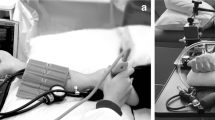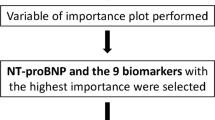Abstract
Aim
Statins have been demonstrated to significantly affect the prognosis and outcome of patients with cardiac diseases. Several studies have suggested pleiotropic effects of the statins in these patients. The present study was designed to examine the effects of atorvastatin on inflammation, endothelial function, cardiac performance and exercise tolerance in patients with idiopathic dilated cardiomyopathy (IDCM).
Methods
Sixty-four patients with IDCM were divided randomly into an atorvastatin treatment group (atorvastatin 10 mg/d orally) and a placebo control group. Before and 12 weeks after the treatment, circulating soluble intercellular adhesion molecule-1 (sICAM-1), Von Willebrand factor (vWF) and C-reactive protein (CRP) levels were detected using enzyme-linked immunosorbent assay (ELISA); Flow-mediated dilatation (FMD) of the brachial artery was measured, and left ventricular ejection fraction (LVEF) and the 6-min walk test (6MWT) evaluated.
Results
After atorvastatin treatment, LVEF increased from 34.5 ± 5.7% to 41.4 ± 4.5% (P < 0.05), and from 32.8 ± 4.0% to 36.9 ± 5.2% (P < 0.05) in the placebo group. Also, the distances covered in the 6MWT increased from 358 ± 61 m to 431 ± 66 m in the atorvastatin group, and from 351 ± 70 m to 382 ± 74 m in the placebo group (both p < 0.05 vs. baseline). The increases in LVEF and 6MWT distances were significantly greater in the atorvastatin than in the placebo group. sICAM-1, CRP and vWF levels decreased and FMD increased significantly in the atorvastatin group, but not in the control group. Correlation analysis showed that the baseline sICAM-1 level was positively correlated with plasma CRP and vWF levels (r = 0.554 and 0.628, respectively); FMD was inversely correlated with serum sICAM-1 and plasma vWF levels (r = −0.579 and −0.590, respectively) and positively correlated with LVEF and distance attained in 6MWT (r = 0.536 and 0.522, respectively).
Conclusions
Twelve weeks of treatment with atorvastatin significantly decreased serum sICAM-1, CRP and vWF levels, and improved the FMD, LVEF and 6MWT outcomes. Inhibition of inflammation, alleviating endothelium damage and endothelial dysfunction might comprise part of the underlying mechanisms leading to the improvement of LV function and exercise tolerance in patients with IDCM.



Similar content being viewed by others
References
Celis R, Torre-Martinez G, Torre-Amione G. Evidence for activation of immune system in heart failure: is there a role for anti-inflammatory therapy? Curr Opin Cardiol. 2008;23:254–60.
Dahl CP, Gullestad L, Fevang B, Holm AM, Landro L, Vinge LE, et al. Increased expression of LIGHT/TNFSF14 and its receptors in experimental and clinical heart failure. Eur J Heart Fail. 2008;10:352–9.
Sola S, Mir MQ, Lerakis S, Tandon N, Khan BV. Atorvastatin improves left ventricular systolic function and serum markers of inflammation in nonischemic heart failure. J Am Coll Cardiol. 2006;47:332–7.
Strey CH, Young JM, Lainchbury JH, Frampton CM, Nicholls MG, Richards AM, et al. Short-term statin treatment improves endothelial function and neurohormonal imbalance in normocholesterolaemic patients with non-ischaemic heart failure. Heart. 2006;92:1603–9.
Khush KK, Waters DD, Bittner V, Deedwania PC, Kastelein JJ, Lewis SJ, et al. Effect of high-dose atorvastatin on hospitalizations for heart failure: subgroup analysis of the treating to new targets (TNT) study. Circulation. 2007;115:576–83.
Kjekshus J, Apetrei E, Barrios V, Bohm M, Cleland JG, Cornel JH, et al. Rosuvastatin in older patients with systolic heart failure. N Engl J Med. 2007;357:2248–61.
Tavazzi L, Maggioni AP, Marchioli R, Barlera S, Franzosi MG, Latini R, et al. Effect of rosuvastatin in patients with chronic heart failure (the GISSI-HF trial): a randomised, double-blind, placebo-controlled trial. Lancet. 2008;372:1231–9.
Kovacs I, Toth J, Tarjan J, Koller A. Correlation of flow mediated dilation with inflammatory markers in patients with impaired cardiac function. Beneficial effects of inhibition of ACE. Eur J Heart Fail. 2006;8:451–9.
Videm V, Albrigtsen M. Soluble ICAM-1 and VCAM-1 as markers of endothelial activation. Scand J Immunol. 2008;67:523–31.
Corretti MC, Anderson TJ, Benjamin EJ, Celermajer D, Charbonneau F, Creager MA, et al. Guidelines for the ultrasound assessment of endothelial-dependent flow-mediated vasodilation of the brachial artery: a report of the International Brachial Artery Reactivity Task Force. J Am Coll Cardiol. 2002;39:257–65.
Hesse B, Lindhardt TB, Acampa W, Anagnostopoulos C, Ballinger J, Bax JJ, et al. EANM/ESC guidelines for radionuclide imaging of cardiac function. Eur J Nucl Med Mol Imaging. 2008;35:851–85.
ATS statement: guidelines for the six-minute walk test. Am J Respir Crit Care Med 2002;166:111–7.
Jonsdottir S, Andersen KK, Sigurosson AF, Sigurosson SB. The effect of physical training in chronic heart failure. Eur J Heart Fail. 2006;8:97–101.
Yin WH, Chen JW, Jen HL, Chiang MC, Huang WP, Feng AN, et al. The prognostic value of circulating soluble cell adhesion molecules in patients with chronic congestive heart failure. Eur J Heart Fail. 2003;5:507–16.
Cugno M, Mari D, Meroni PL, Gronda E, Vicari F, Frigerio M, et al. Haemostatic and inflammatory biomarkers in advanced chronic heart failure: role of oral anticoagulants and successful heart transplantation. Br J Haematol. 2004;126:85–92.
Fischer D, Rossa S, Landmesser U, Spiekermann S, Engberding N, Hornig B, et al. Endothelial dysfunction in patients with chronic heart failure is independently associated with increased incidence of hospitalization, cardiac transplantation, or death. Eur Heart J. 2005;26:65–9.
Bauersachs J, Hiss K, Fraccarollo D, Laufs U, Ruetten H. Simvastatin improves left ventricular function after myocardial infarction in hypercholesterolemic rabbits by anti-inflammatory effects. Cardiovasc Res. 2006;72:438–46.
Takemoto M, Node K, Nakagami H, Liao Y, Grimm M, Takemoto Y, et al. Statins as antioxidant therapy for preventing cardiac myocyte hypertrophy. J Clin Invest. 2001;108:1429–37.
Mulder DJ, van Haelst PL, Wobbes MH, Gans RO, Zijlstra F, May JF, et al. The effect of aggressive versus conventional lipid-lowering therapy on markers of inflammatory and oxidative stress. Cardiovasc Drugs Ther. 2007;21:91–7.
Hernandez-Perera O, Perez-Sala D, Navarro-Antolin J, Sanchez-Pascuala R, Hernandez G, Diaz C, et al. Effects of the 3-hydroxy-3-methylglutaryl-CoA reductase inhibitors, atorvastatin and simvastatin, on the expression of endothelin-1 and endothelial nitric oxide synthase in vascular endothelial cells. J Clin Invest. 1998;101:2711–9.
Nachtigal P, Pospisilova N, Jamborova G, Pospechova K, Solichova D, Andrys C, et al. Atorvastatin has hypolipidemic and anti-inflammatory effects in apoE/LDL receptor-double-knockout mice. Life Sci. 2008;82:708–17.
Graciano AL, Bryant DD, White DJ, Horton J, Bowles NE, Giroir BP. Targeted disruption of ICAM-1, P-selectin genes improves cardiac function and survival in TNF-alpha transgenic mice. Am J Physiol Heart Circ Physiol. 2001;280:H1464–71.
Wojnicz R, Wilczek K, Nowalany-Kozielska E, Szygula-Jurkiewicz B, Nowak J, Polonski L, et al. Usefulness of atorvastatin in patients with heart failure due to inflammatory dilated cardiomyopathy and elevated cholesterol levels. Am J Cardiol. 2006;97:899–904.
Node K, Fujita M, Kitakaze M, Hori M, Liao JK. Short-term statin therapy improves cardiac function and symptoms in patients with idiopathic dilated cardiomyopathy. Circulation. 2003;108:839–43.
Lee R, Chan YH, Wong J, Lau D, Ng K. The 6-minute walk test predicts clinical outcome in Asian patients with chronic congestive heart failure on contemporary medical therapy: a study of the multiracial population in Singapore. Int J Cardiol. 2007;119:168–75.
Jordan AJ, Anguita MP. Effect of statin treatment on mortality in a large cohort of heart failure patients. Rev Esp Cardiol. 2009;62:323–7.
Author information
Authors and Affiliations
Corresponding author
Rights and permissions
About this article
Cite this article
Liu, M., Wang, F., Wang, Y. et al. Atorvastatin Improves Endothelial Function and Cardiac Performance in Patients with Dilated Cardiomyopathy: The Role of Inflammation. Cardiovasc Drugs Ther 23, 369–376 (2009). https://doi.org/10.1007/s10557-009-6186-3
Published:
Issue Date:
DOI: https://doi.org/10.1007/s10557-009-6186-3




